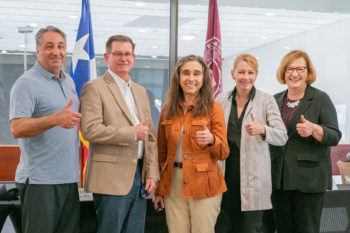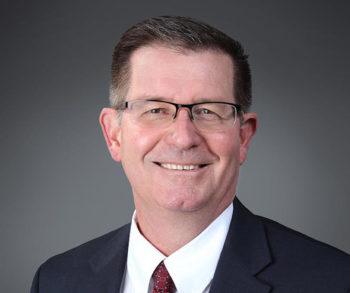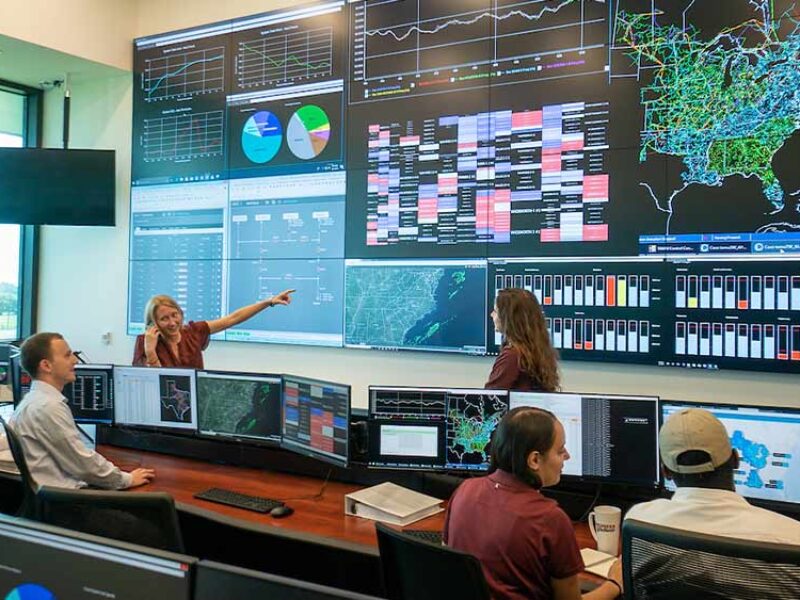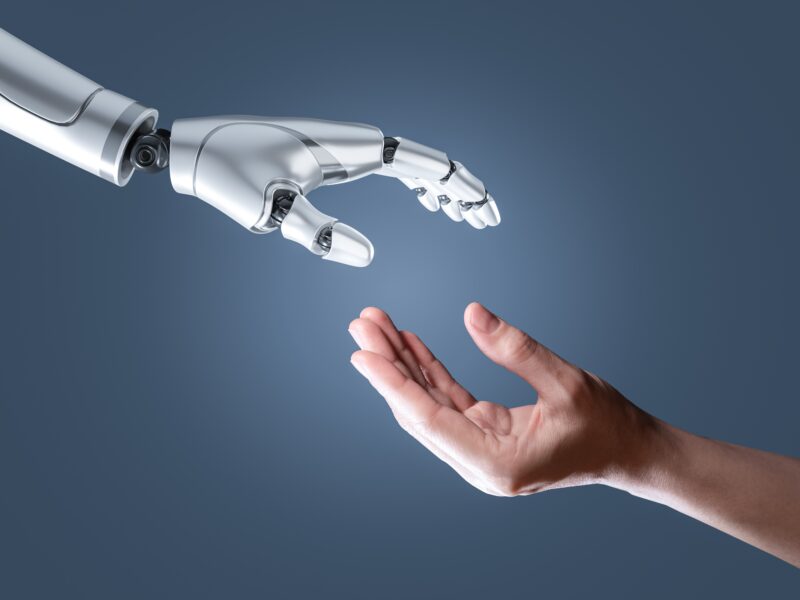Meet The Aggie Leading Sandia National Laboratories

Texas A&M University former student James S. Peery ’90, director of labs at Sandia National Laboratories in Albuquerque, N.M., visited campus late last month to meet with university officials and tour facilities including Disaster City, the Global Health Research Complex, the RELLIS Campus, and the National Aerothermochemistry and Hypersonics Laboratory. Peery directs all missions at Sandia, the engineering arm of the U.S. nuclear weapons enterprise and premier science and engineering laboratories for national security and technology innovation. He was named a 2020-21 outstanding alumni by the Texas A&M College of Engineering.

Peery earned three degrees in nuclear engineering from Texas A&M: his bachelor’s in 1984, master’s in 1986 and a Ph.D. in 1990. Upon earning his doctorate, he joined Sandia, where he worked in radiation hydrodynamics and managed a computational physics group. In 2002, he left Sandia to lead the Advanced Simulation and Computing program at Los Alamos National Laboratory under the National Nuclear Security Administration’s Stockpile Stewardship Program and subsequently, the Hydrodynamics Experiments Division. He returned to Sandia in 2007, staying for another decade until moving to Oak Ridge National Laboratory to continue working in national security. In January 2020, he was named director of labs at Sandia.
Texas A&M Today spoke with Peery about his job, Texas A&M’s long history with Sandia Labs and his time as a student in Aggieland.
Tell us about the mission and purpose of Sandia National Laboratories.
The national laboratories were set up to solve some of the most challenging science, engineering and technology problems that the nation has. It is a team sport to solve these multidisciplinary problems. Every one of the national labs is different in its capabilities and competencies. Sandia is the Department of Energy’s only engineering laboratory, but we’re backed by outstanding science. Our primary mission is to steward the nuclear weapons of the United States and our role is to ensure these weapons are secure, safe and reliable. Our motto is “Always, Never” – they will always work when the president orders them to work and they will never work when not authorized. We do a lot of other national security work where we use those capabilities and competencies for nuclear weapons to help other agencies in the federal government solve challenging problems.
How has Sandia’s role evolved to address additional, complex threats facing our country?
Going back into history, Los Alamos was the primary location for the Manhattan Project during World War II that developed our first nuclear weapons. It was President Truman who realized he was going to need an engineering laboratory and so effectively until the 1960s, Sandia’s role was almost exclusively supporting Los Alamos and Lawrence Livermore. In the ’60s we got involved in helping the Department of Defense in the Vietnam War. In the ’70s we had an energy crisis and Sandia was very involved in renewable energy – solar, photovoltaic, hydrological, and so on. Later, many of those capabilities were spun off into what today is the National Renewable Energy Laboratory. Post 9/11, we became heavily involved in counter-terrorism and non-proliferation. And currently we’re having to refurbish most of the U.S. nuclear stockpile; we didn’t touch them for a several decades, they age and now it’s time to go in and refurbish these weapons.
What is the relationship between Sandia and Texas A&M?
There’s a long history between Sandia National Labs and Texas A&M. When I was in graduate school, Sandia recruited very heavily from Texas A&M mechanical, electric and nuclear engineering. The other national labs caught onto that and started showing up as well. Over time, Sandia and the other labs became heavily involved with Texas A&M in areas such as advanced simulation and computing through the Predictive Science Academic Alliance Program II, which was executed by the Center for Large Scale Scientific Simulations. And we’ve been discussing for quite some time a more strategic relationship between the two institutions. Mainly the history has been principal investigator to principal investigator. We have also participated in reviewing each other – professors reviewing some of our programs, and some of us reviewing different departments at the university. We’re trying to evolve that into a much more strategic relationship. And a lot of the activities that the university has moved into are making that much more attractive for both of us. RELLIS is getting close to the kind of work that Sandia does, more on the lower technology readiness levels than we typically work, but a lot of synergies, for example, hypersonics. Clearly there’s a lot of investment in hypersonics at Texas A&M. And there’s probably no institution in the country more knowledgeable in hypersonics than Sandia, so there’s great synergy there. That’s just one example of many shared activities.
How important of a role do universities have in helping find solutions to our nation’s most challenging national security problems?
Universities are doing cutting-edge research. That is important to our missions – taking things from lower-technology readiness levels on to demonstrations. Typically, the national labs are in that mode of demonstrating and then passing it off to industry. So universities play a very important role in furthering research that can end up being vital to national security.
Marvin Adams was just named to the President’s Council of Advisors on Science and Technology. Tell us about some of the work you’ve done with Dr. Adams.
First off, I’d like to say that’s a very prestigious recognition of Dr. Adams and all the work he’s done. I can’t point to a project that both Dr. Adams and I have worked on together, but we have both worked in the interest of many important national security programs. Typically, it’s either been research that he and his graduate students have performed for new algorithms going into certain codes at the labs. That was certainly true when I was at Los Alamos. He and Dr. Jim Morel have been instrumental in developing some state-of-the-art algorithms and codes for the national laboratories. Dr. Adams and I have also been participants in various reviews for programs and decisions in those programs to make sure that the nation is going in the right direction.
You came to Texas A&M for your undergraduate, then your master’s degree and finally your doctorate. What made you choose Texas A&M and remain with the institution for all three degrees?
I went to Strake Jesuit High School in Houston and so it’s expected you’re going to go to college. It’s the greatest gift my parents ever gave me, was sending me there. My parents were of modest means. They said I could live at home and go to University of Houston or Rice. But I was very determined to go off to college. I had friends who were going to Texas A&M and so I checked out their offerings. My dad is a mechanical engineer and I had done a little bit of that during the summers, but I knew that’s not exactly what I wanted to do. I love math and physics, and it just seemed like nuclear engineering was the right place for me. So I came to A&M and fell in love with it. I remember being in the Zachry engineering building where there’s this great set of marble steps leading up to a platform and they called all the freshmen engineering students there a few days before classes began. The dean said, ‘Look to your left and look to your right because those people are not going to be here when you graduate.’ I took that as a challenge and worked incredibly hard to get my undergraduate degree. Then the Department of Nuclear Engineering provided me an opportunity to stay for graduate school and make me a research assistant to pay the bills. So I didn’t ever think about leaving to go to another university.
What do you think of your alma mater all these years later and with President M. Katherine Banks leading the way?
First I must say, I received a fabulous education from the Nuclear Engineering Department at Texas A&M. I was totally prepared to go to a national lab and be successful. Not only the foundational elements of the education, but the challenges that professors put in front of me and my research. I was fortunate to be on some team projects so I knew how to work on a team. On my recent visit, I remember talking to Diane Hurtado about how we watch China and all this stuff they’re able to do these days and how fast they do it. And we kind of sit back in awe. But I sit back in awe looking at what Texas A&M in College Station is doing both in the increasing the number of undergraduates in engineering, the new facilities, the RELLIS Campus, that’s what is awe inspiring to me. My degrees are gaining value on the wall based on what Dr. Banks and the leadership team at Texas A&M are doing. I’m very bullish for the future of Texas A&M, one of the world’s greatest universities, and for the two institutions to partner more and grow stronger together.
Is there anything you’d like to add?
I want to give a shout out to the professors who helped me get where I am today. I’m sure I’ll leave someone off, and some of them are no longer with us. Dr. Ron Hart, Dr. Lee Peddicord, Dr. Fred Best, Dr. John Poston, Dr. Ted Parish and Dr. Yassin Hassan, they challenged me. It was a family and they truly cared about us students and getting us through our education. There’s not a better nuclear engineering department in the country.
Media contact: Lesley Henton, 979-845-5591, lshenton@tamu.edu





